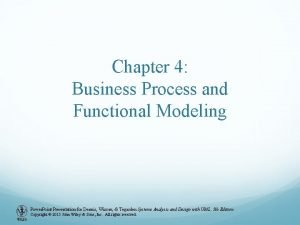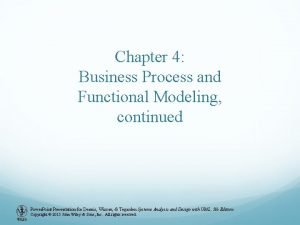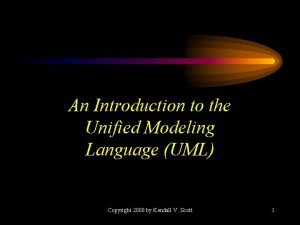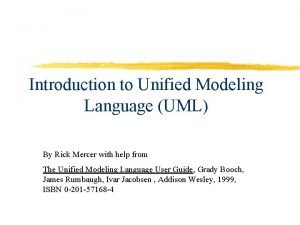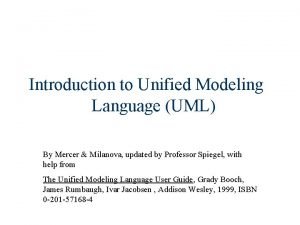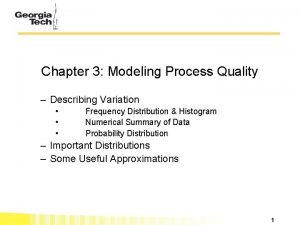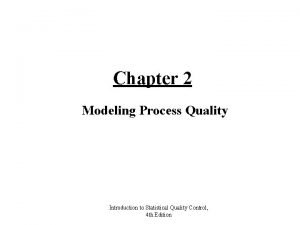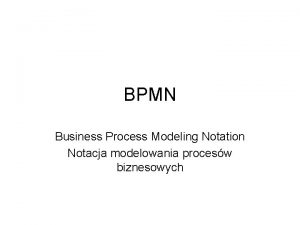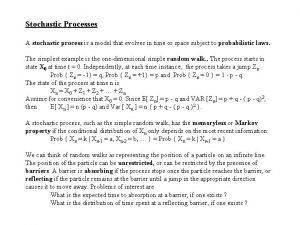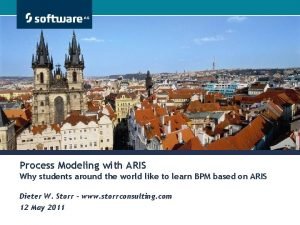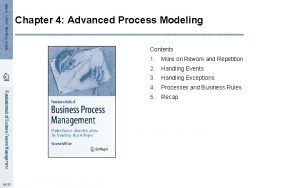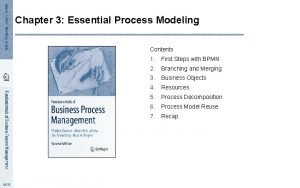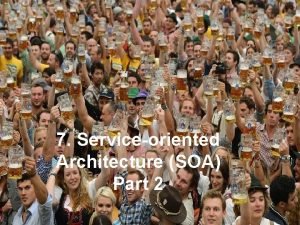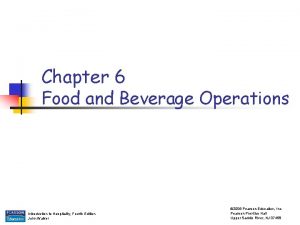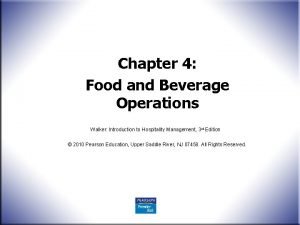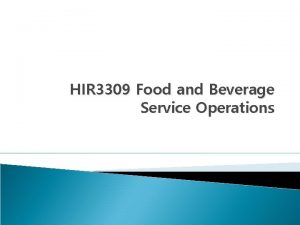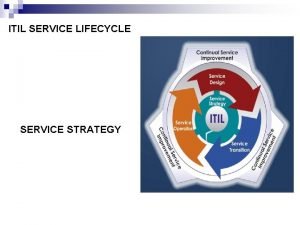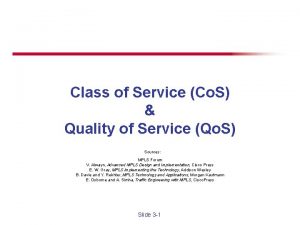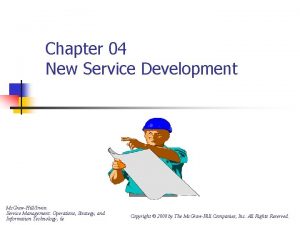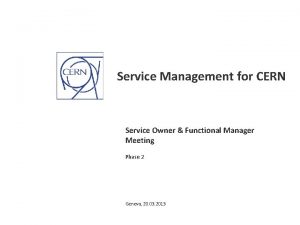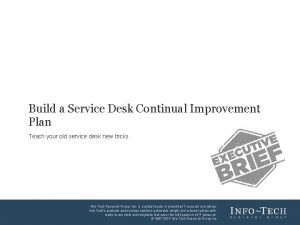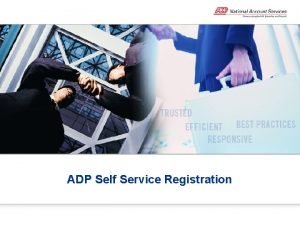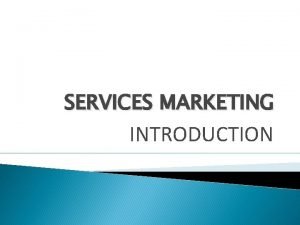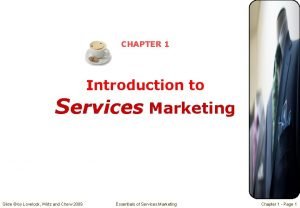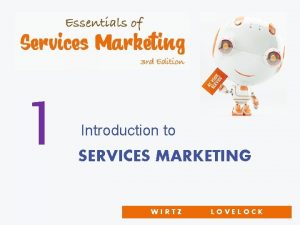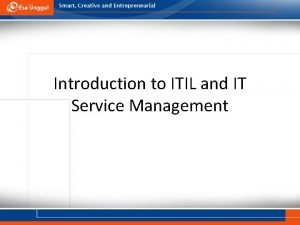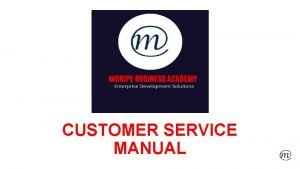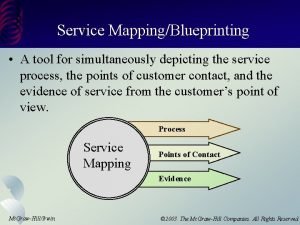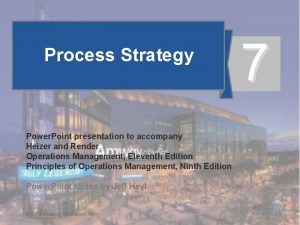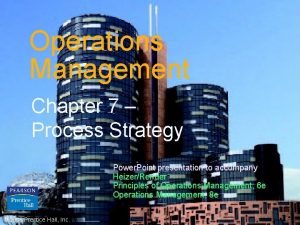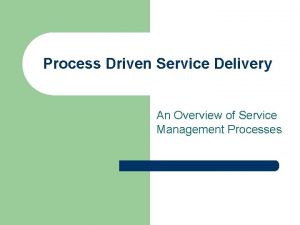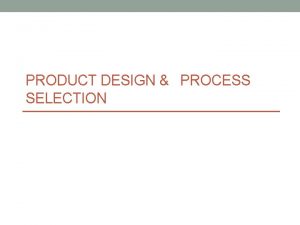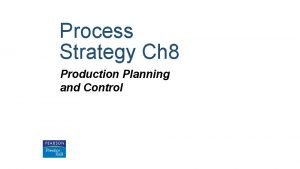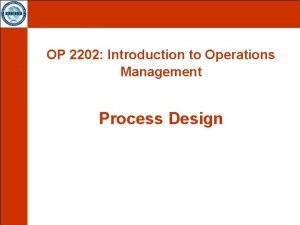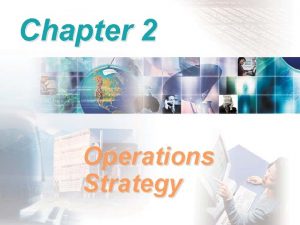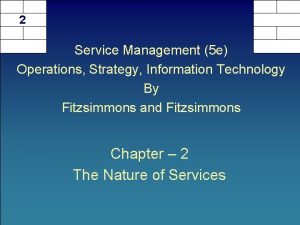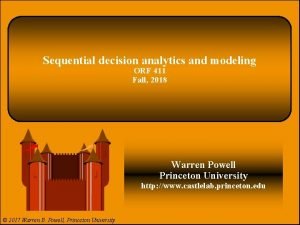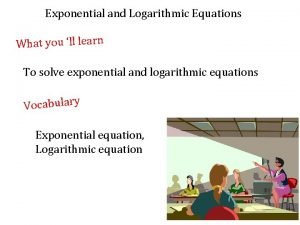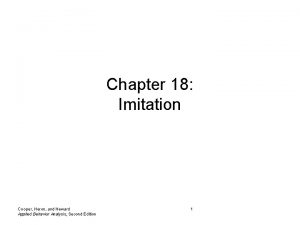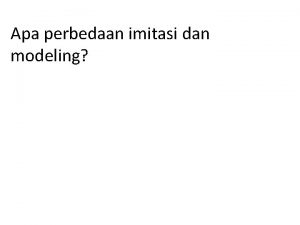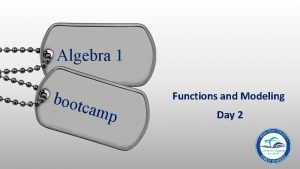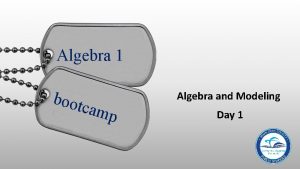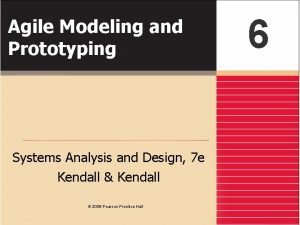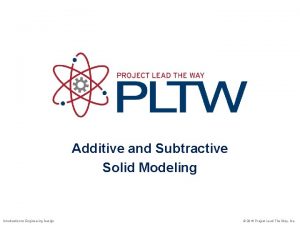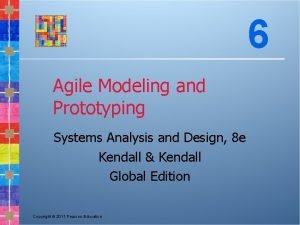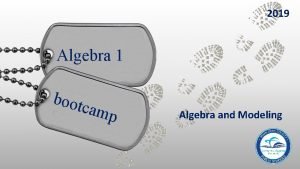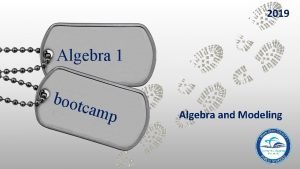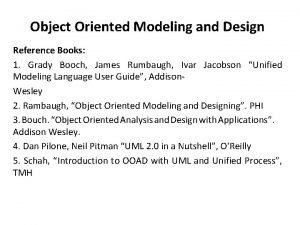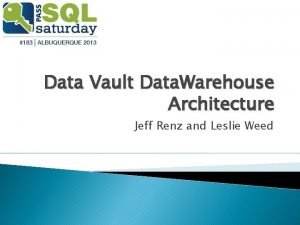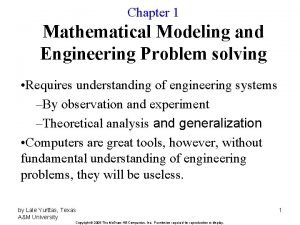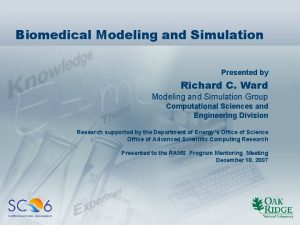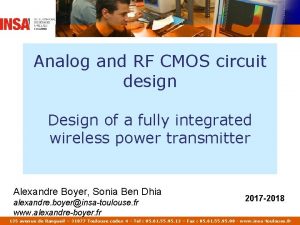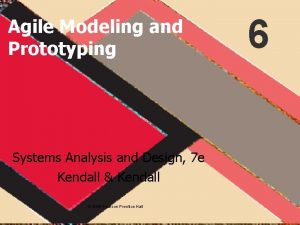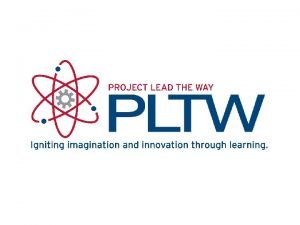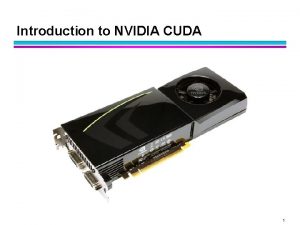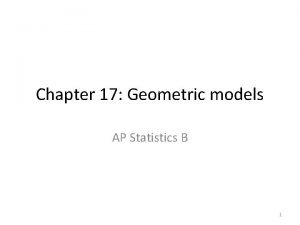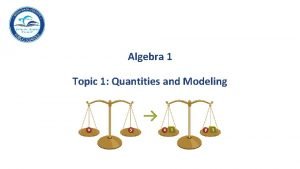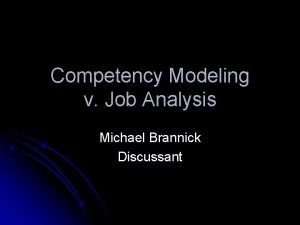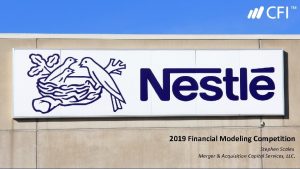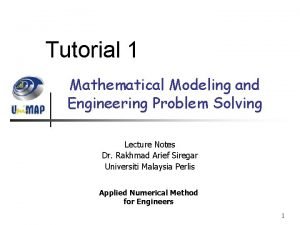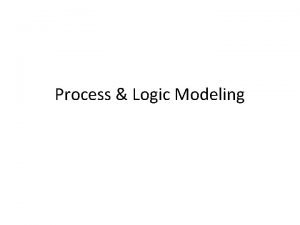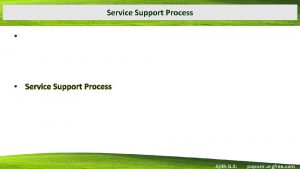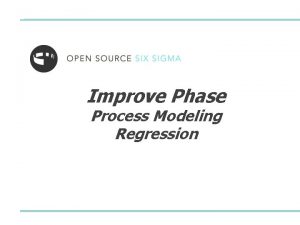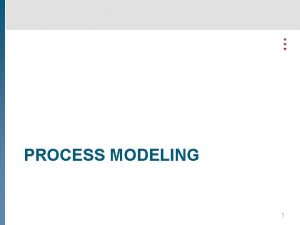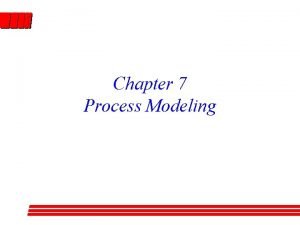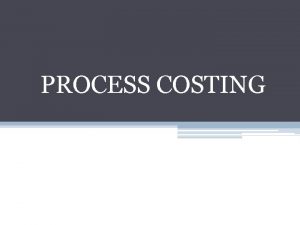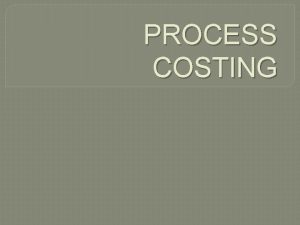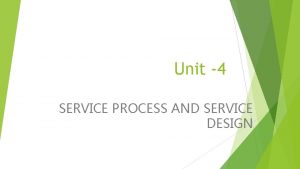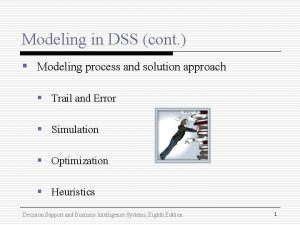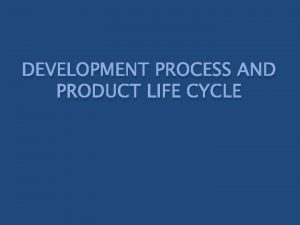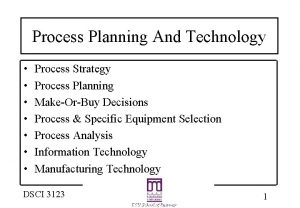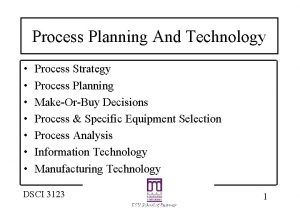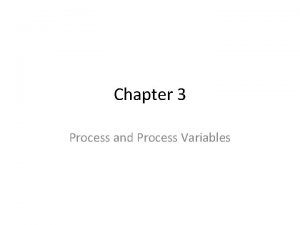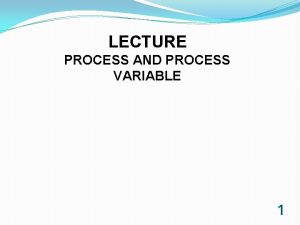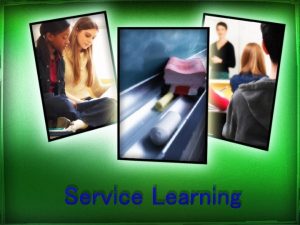Introduction to modeling Process and Service modeling 1

























































![Service capability [optional] • A capability identify a cohesive set of functions or resources Service capability [optional] • A capability identify a cohesive set of functions or resources](https://slidetodoc.com/presentation_image_h/fffb8f5af133ca40d5cc7004233c7273/image-58.jpg)







![Service contract behaviour [optional] • The service contract behaviour specifies the behaviour of a Service contract behaviour [optional] • The service contract behaviour specifies the behaviour of a](https://slidetodoc.com/presentation_image_h/fffb8f5af133ca40d5cc7004233c7273/image-66.jpg)







![Service choreographies [optional] • It specifies the behaviour of a Service Interface. – Usefull Service choreographies [optional] • It specifies the behaviour of a Service Interface. – Usefull](https://slidetodoc.com/presentation_image_h/fffb8f5af133ca40d5cc7004233c7273/image-74.jpg)



![Services orchestration: Purpose [optional] • Orchestration of the services. – It is a refinement Services orchestration: Purpose [optional] • Orchestration of the services. – It is a refinement](https://slidetodoc.com/presentation_image_h/fffb8f5af133ca40d5cc7004233c7273/image-78.jpg)



- Slides: 81

Introduction to modeling Process and Service modeling 1

Where are we? # Title Date 1 Introduction 01. 10. 2014 2 General concepts 15. 10. 2014 3 ORM modeling 22. 10. 2014 4 Relational modeling 12. 11. 2014 5 ER modeling 19. 11. 2014 6 OO modeling and ontologies 10. 12. 2014 7 Process and Service modeling 07. 01. 2015 8 Exam 21. 01. 2015 2

Process modelling 3

What is a process? • A sequence of actions to reach a certain goal • Actions take inputs and produce outputs 4

What is a business process? • A collection of related, structured activities or tasks that produce a specific service or product (serve a particular goal) for a particular customer or customers. – http: //en. wikipedia. org/wiki/Business_process • A business process can be: – Split in simple activities – These activities have to be performed by a participants (someone or something) 5

Types of business processes • Management processes – processes that govern the operation of a system. Typical management processes include "corporate governance" and "strategic management". • Operational processes – processes that constitute the core business and create the primary value stream. Typical operational processes are purchasing, manufacturing, advertising and marketing, and sales. • Supporting processes, – which support the core processes. Examples include accounting, recruitment, call center, technical support. 6

What is business process modeling? Process models Real world process Modeling 7

What can I use to model process? • Business Process Modeling Notation • Business Process Modeling Notation (BPMN) provides businesses with the capability of defining and understanding their internal and external business procedures through a Business Process Diagram, which will give organizations the ability to communicate these procedures in a standard manner. • The core set of modeling elements enable the easy development simple Business Process Diagrams that will look familiar to most Business Analysts (a flowchart diagram) 8

BPMI. org Hourglass Audiences: Business Environment Purposes: BPMN Modeling Strategy Consultants Business Analysts Process Designers System Architects Software Engineers Focus BP Scope BPEL Java Execution Technology Implementation 9 9

BPMN elements 10 10

Tasks • • • A Task is an atomic activity that is included within a Process Used when the work in the Process is not broken down to a finer level of Process Model detail There are specialized types of Tasks for sending and receiving, or userbased Tasks, etc. Markers or icons can be added to Tasks to help identify the type of Task Markers must not change the footprint of the Task or conflict with any other standard BPMN element 11

Sub-processes • • • Sub-Processes enable hierarchical Process development A Sub-Process is a compound activity that is included within a Process. • Can be broken down into a finer level of details (a Process) through a set of sub-activities For a collapsed version of a Sub-Process, the details of the Sub-Process are not visible in the Diagram. • A “plus” sign in the lower-center of the shape indicates that the activity is a Sub-Process and has a lower level of detail For an expanded version of a Sub-Process, the details (a Process) are visible within its boundary There are two types of Sub-Processes: Embedded and Independent (reusable) 12 12

Pool • • • Pools represent Participants in an interactive (B 2 B) Business Process Diagram A Participant may be a business role (e. g. buyer or seller) or may be a business entity (e. g. IBM or OMG) A Pool may be a “black box” or may contain a Process Interaction between Pools is handled through Message Flow Sequence Flow cannot cross the boundary of a Pool (i. e. a Process is fully contained within a Pool) 13 13

Lanes • Lanes represent sub-partitions for the objects within a Pool • They often represent organization roles (e. g. Manager, Associate), but can represent any desired Process characteristic • Sequence Flow can cross Lane boundaries 14 14

Connectors • A Sequence Flow is used to show the order in that activities will be performed in a Process • A Message Flow is used to show the flow of messages between two entities that are prepared to send and receive them • An Association is used to associate data, information and artifacts with flow objects 15 15

Gateways • Gateways are modeling elements that are used to control how Sequence Flows interact as they converge and diverge within a Process • All Types of Gateways are diamonds • Different internal markers indicate different types of behavior • All Gateways both split and merge the flow • If the flow does not need to be controlled, then a Gateways is not needed. Thus, a diamond represents place where control is needed 16 16

Exclusive Gateways • • • Exclusive Gateways (Decisions) are locations within a business process where the Sequence Flow can take two or more alternative paths. This is basically the “fork in the road” for a Process Only one of the possible outgoing paths can be taken when the Process is performed There are two types of decision mechanisms: – Data (e. g. condition expressions) – Events (e. g. the receipt of alternative message) • They are also used to merge Sequence Flow 17

Exclusive Gateways, based on data • Most commonly used type of Gateways • Can be shown with or without an internal “X” marker. Without is the most common usage. • The Gateways (Decisions) create alternative paths based on defined conditions 18 18

Exclusive Gateways, based on events • This type of Decision represents a branching point in the process where the alternatives are based on events that occur at that point in the Process, rather than conditions • The Multiple Intermediate Event is used to identify this Gateway • The Event that follows the Gateway Diamond determines the chosen path • The first Event triggered wins 19 19

Inclusive Gateways • Inclusive Gateways are Decisions where there is more than one possible outcome • The “O” marker is used to identify this Gateway • They are usually merging Inclusive Gateway 20 20

Complex Gateways • Complex Gateways are Decisions where there is more advanced definitions of behavior can be defined • The asterisk marker is used to identify this Gateway • Complex behavior can be defined for both the merging and splitting behavior 21 21

Parallel Gateways • Parallel Gateways are places in the Process where multiple parallel paths are defined: • They are not required forking in most situations • They can be used for methodological purposes • The “+” marker is used to identify this Gateway • The Gateway is also used to synchronize (wait for) parallel paths 22 22

Complete Set of Diagram Elements, Events • An Event is something that “happens” during the course of a business process • Events affect the flow of the Process and usually have a trigger or a result. • Can start, interrupt, or end the flow 23 23

Complete Set of Diagram Elements, Gateways • Gateways are modeling elements that are used to control how Sequence Flows interact as they converge and diverge within a Process • If the flow does not need to be controlled, then a Gateway is not needed 24 24

BPMN Modeling Example 25 25

Service modelling 26

Soa. ML • ”A service is value delivered to another through a well-defined interface and available to a community (which may be the general public). A service results in work provided to one by another. ” • Service Oriented Architecture (SOA) is a way of describing and understanding organizations, communities and systems to maximize agility, scale and interoperability. • SOA, then, is an architectural paradigm for defining how people, organizations and systems provide and use services to achieve results. • Soa. ML provides a standard way to architect and model SOA solutions using the Unified Modeling Language (UML). 27

Soa. ML – Scope • Extensions to UML 2. 1 to support the following new modeling capabilities: – – – Identifying services Specifying services Defining service consumers and providers Policies for using and providing services Defining classification schemes Defining service and service usage requirements and linking them to related OMG metamodels, such as the BMM and BPMN 2. 0 • Soa. ML focuses on the basic service modelling concepts – A foundation for further extensions both related to integration with other OMG metamodels like BPMN 2. 0, SBVR, OSM, ODM and others • Soa. ML is NOT a methodology 28

Soa. ML – Key concepts • Services architecture – specification of community – Participants – role – Service contracts – collaboration (provide and consume) • Service contract – specification of service – Role – Provider and consumer – Interfaces – Choreography (protocol, behaviour) • • • Service interface – bi-directional service Simple interface – one-directional service Message Type – data exchanged between services 29

Order Conformation Provider Consumer Marketplace Services – Example Shipped Mechanics Are Us Dealer Acme Industries Manufacturer Consumer Status Ship Req Shipped Provider Physical Delivery Consumer Provider Delivered Get. It. There Freight Shipper 30

Services architecture Purchasing service Ship Status service Shipping service • A Services. Architecture (or SOA): – is a network of participant roles providing and consuming services to fulfil a purpose. – defines the requirements for the types of participants and service realizations that fulfil those roles. – It is defined using a UML Collaboration. 31

Inside the Manufacturer Order Conformation Shipped Service Ship Req Shipped Delivered 32

Service contract • A Service. Contract: – Fully specifies the service (terms, conditions, interfaces, choreography, etc. ) – is binding on both the providers and consumers of that service. – is defined using a UML collaboration that is focused on the interactions involved in providing a service. • A participant plays a role in the larger scope of a Services. Architecture and also plays a role as the provider or user of services specified by Service. Contracts. 33

Service contract Service Contract Role within service Service interface corresponding to role Information processed by order processor type Service interface corresponding to role Information received by orderer • The service contract specifies the details of the service – what information, assets and responsibilities are exchanged and under what rules. 34

Simple protocol choreography for Ordering service contract • Behaviour in Soa. ML can also be specified with Activity Diagrams or State Machines. 35

Participants Participant • Participants: – represent logical or real people or organizational units that participate in services architectures and/or business processes. – provide and use services, defining their external contract 36

Service Choreography for “Place Order” The role of the consumer (a participant that places orders) and the consumers interface The optional interaction to return the quote The role of the provider (an order taker) and their interface The optional interaction to request a quote The required interaction to place an order The required interaction to accept or reject the order A more detailed look at the same service. Note that this models a fully asynchronous SOA – like most business interactions, the document message types are detailed on the next page. 37 37

Message Detail for Place Order This is the detail for the message types that correspond to the interactions for the place order service. Note that at the technology level this can produce XML schema for the messages. 38 38

Example Information Model 39 39

Linking messages to business information SOA Messages can reference and include parts of the logical information model – forming a connection between SOA and enterprise data 40 40

Linking the Business Process A business process represents the desired behavior among the various participants in a services architecture. This is modeled here as a UML activity. Each participant is given a swimlane which contains the actions carried out by that participant within the business process. The overall behavior emerges as an orchestration of the actions carried out by each of the participants. Interactions with participants must be consistent with the service contracts by which they interact. 41 41

Service ports and service participants • A Service port: – is the offer of a service by one participant to others using well defined terms, conditions and interfaces – defines the connection point through which a Participant offers its capabilities and provides a service to clients. – It is defined using a UML Port on a Participant, and stereotyped as a <<Service>> • A Service port is a mechanism by which a provider Participant makes available services that meet the needs of consumer requests as defined by Service. Interfaces, Interfaces and Service. Contracts. 42

Service interface • A Service. Interface: – can type a service port. – can specify a bi-directional service (both the provider and consumer have responsibilities to send and receive messages and events). • A Service. Interface is defined from the perspective of the service provider using three primary sections: – provided and required Interfaces – Service. Interface class – protocol Behavior. 43

Participant with service and request ports • • • A Service Port is typed by a Service. Interface A Request port is typed by a conjugate Service. Interface (defines the use of a service rather than its provision). This will allow us to connect service providers and consumers in a Participant. Can be transformed to the appropriate interface/implementation code. 44

Interfaces for Participants Each role in the service that receives interactions has an interface, this is the interface for a logical technology component and is implemented by components providing or using this service. This service is bi-directional messages flow in both directions. Interfaces will correspond with parts of WSDL in a web services mapping of Soa. ML 45 45

Logical System Components implement the service interfaces providing the link to systems. Participants and services may be used in multiple architectures. “Ports” on the participating components provide and require the service interfaces for each service 46 provided or used 46

Composite Application Components Enterprise systems can be integrated with adapter components This component is defined as a composition of other components. Or, new implementation can be defined inside of components. Components can be assembled from other components by linking their services. This corresponds to the architecture for Acme. 47 47

Business Architecture Model (BAM) 2. Information Semantics 1. Business Goals 3. Business Processes 4. Capabilities 6. Service Contracts and Behaviour 7. Model to Model (M 2 M) Software Architecture Model (SAM) 9. Interfaces and Messages 5. Services Architecture Transformation 8. Service Interfaces 10. Service Choreographies 12. Services Orchestration 11. Software Components 13. Model to Text (M 2 T) Platform. Specific Model (PSM) Transformation Cloud, Web Services, JEE, MAS, P 2 P/Grid, SWS CIM 48 PIM PSM 48

Business Architecture Model (BAM) • The BAM is used to express the business operations and environment which the service-oriented architecture is to support. • The BAM models for capturing business requirements and identify services within a service-oriented architecture: – Goals – Information semantics (used terminologies, ontologies) – Business processes with associated organisation roles and information elements – Capabilities • The BAM further describes: – The Services. Architecture of the business community – The Service. Contracts between the business entities participating in the community 49

Service Architecture Model (SAM) • The SAM describes the overall architecture of the system at the PIM level. It partitions the system into components and interfaces. • A structural model describes the components, their dependencies, and their interfaces: – Service Interfaces – Interfaces and Messages – Software Components • A dynamic model describes the component interactions and protocols: – Service Choreographies – Services Orchestration 50

Case study: Travel Agency – Reserve a Travel: Client Reserve Pay Cancel • A Travel Agency has some contact with Partner Agencies which provide reservation for Flights, Hotels, Cars, etc. • A Client can interact with the Travel Agency to: Travel Agency • The Travel Agency need to be in contact with a Visa payment center in order to be paid by the Client, and pay back the Partner Agencies. Payment facilities – Cancel a Travel – Pay the Travel Visa Travel reservation facilities • Flight, Flight+Hotel+Car, etc. Partner Agency 51

Business Architecture Modelling: overview 52 52

Business Goals • Business Motivation Model (BMM) identifies and defines: (excerpt) – the factors that motivate the business plan. – the elements of a business plan • Modelling steps: 1. Identify Goals 2. Specify Goals and their relationships 3. Perform goal analysis linking the goals to existing potential new business processes 53

Core concept for BMM 54

Information Semantics • Captures core terminology in dictionaries and explicitly specifies the relations between terms • Modelling steps: 1. Capture terms in dictionaries 2. Model explicitly terms and the relations between them, potentially using ontologies 55

Business Process (1/2) • Business Process Modelling Notation (BPMN) defines: – Roles of the business – Task flows (detailed specifications of the business services) 1. Identify Business Processes 2. Detailing of business processes 1. Identify business entities and model them as Pools or Swimlanes. • They will be associated with Participants in Soa. ML 2. Focus on the tasks that describe the interaction points between the business entities. • These interactions will be identified with Service. Contracts in Soa. ML 3. Identify the control and data flows between these tasks. • Data objects will be associated with Message. Type in Soa. ML 56

Business Process (2/2) Client Travel. Agency Partner. Agency Visa. Payment. Center 57 57
![Service capability optional A capability identify a cohesive set of functions or resources Service capability [optional] • A capability identify a cohesive set of functions or resources](https://slidetodoc.com/presentation_image_h/fffb8f5af133ca40d5cc7004233c7273/image-58.jpg)
Service capability [optional] • A capability identify a cohesive set of functions or resources that a service provided by one or more participants might offer. – They should be specified only for big systems and systems of systems. • • Capabilities are used to identify needed services and to organise them into catalogues. The capability may specify dependencies to other capabilities or internal process to detail how that capability is provided. Capabilities are shown in context using a service dependencies diagram. Modelling steps: 1. Identify capabilities (using goal service modelling, domain decomposition or existing assets analysis) 2. Refine the capabilities (abstract operations, can be incomplete signature) 3. Link the Soa. ML: Capabilities to the BMM: Goals 58

Services architecture: Purpose • A Services. Architecture describes how participants work together for a purpose by providing and using services expressed as service contracts. • By expressing the use of services, the Services. Architecture implies some degree of knowledge of the dependencies between the participants in some context. • Each use of a service in a Services. Architecture is represented by the use of a Service. Contract bound to the roles of participants in that architecture. • Both service contracts and participants can be reused when composing different services in other Services. Architectures. 59

Services architecture: Modelling steps 1. Create a Service Architecture – Create a UML Collaboration with <<Services. Architecture>> 2. Identify the Participants. – Identify the different Participants involved in the Service. Architecture • There is often a 1 -1 mapping between BPMN: Pool and Soa. ML: Participant – Participants are components with <<Participant>>. 3. Identify the Service Contracts. – Interactions between Participants will be categorised as Service Contracts – A Service Contract is a UML Collaboration with <<Service. Contract>>. 4. Specify the Services Architecture. – Use the Service Contracts and Participants to build the Service Architecture • Roles in the UML Collaboration are typed by the identified Participants • UML Collaboration Uses are linked to the Service Contracts. – Bind the different Roles to the appropriate Collaboration Uses, hence specifying how Participants will interact. 60

Service Architecture: Example (1/2) Client Each Pool can be mapped to a Participant Travel. Agency Partner. Agency Visa. Payment. Center Interactions between Pools are categorised as Service Contracts 61 61

Service architecture: Example (2/2) 1. Create a Services. Architecture 2. Identify Participants 3. Identify Service. Contracts 4. Bind the Participants to the Service Contracts 62

Service contract: Purpose • Defines service specifications that define the roles each participant plays in the service and the interfaces they implement to play that role – These interfaces will type the ports on the participant – The service is specified without regard for realization, capabilities or implementation, hence providing for the loose coupling of the SOA paradigm. • In most cases a Service. Contract will specify two roles (provider & consumer) – but other roles may be specified. • The Service. Contract may also own a behaviour that specifies the exchanges between the parties 63

Service contract: Modelling steps 1. Identify the Service Contract – (see previous slides on Services. Architecture) 2. Identify the roles. – Identify the providers and consumers of the Service Contract. – They are specified as Roles typed by an Interface. – The Roles are connected by a Service Channel. 3. Specify the interfaces at business level – Specify the business operations used in the interface. 64

Service contract: Example 65
![Service contract behaviour optional The service contract behaviour specifies the behaviour of a Service contract behaviour [optional] • The service contract behaviour specifies the behaviour of a](https://slidetodoc.com/presentation_image_h/fffb8f5af133ca40d5cc7004233c7273/image-66.jpg)
Service contract behaviour [optional] • The service contract behaviour specifies the behaviour of a Service Contract. – It should be specified only for complex services (many states) • It expresses the expected business interactions between the consumers and providers of services. • It can be specified as any UML Behavior • Modelling steps: 1. Create a Service. Contract behaviour diagram (Activity, Interaction or State. Machine) 2. Define the message sequence between the provider and consumer interfaces. 66

Software Architecture Modelling: overview • The Software Architecture Modelling will refine the models of the Business Architecture Modelling. 67

Service interfaces: Purpose • A Service. Interface defines the interface and responsibilities of a participant to provide or consume a service. – Service. Interfaces refine the Service. Contracts specified in the BAM • It is used as the type of a Port of a Participant. • Service. Interface are reusable protocol definitions in different Participants providing or consuming the same Service. • Simple interface approach – focuses the attention on a one-way interaction provided by a participant on a port represented as a <<Provider>> UML interface. • Service interface based: – allows for bidirectional services, with ”callbacks” from the provider to the consumer – may include specific protocols, commands and information exchange. 68

Service interface: Modelling steps 1. Define the Service Interfaces. – Create the Service. Interface as a UML Interface with <<Service. Interface>>. 2. Define the provided Interface. – Create a UML Interface with <<Provider>> 3. Define the consumer Interface. – Create a UML Interface with <<Consumer>> – The consumer interface is specified only when callbacks are needed. 4. Link the Provided and Consumer Interfaces to the Service. Interface – Create an Interface. Realization between the Provider Interface and the Service. Interface – Create a Usage link between the Consumer Interface and the Service. Interface 5. Create and link a Conjugate Service. Interface – Create a Conjugate Service. Interface as a <<Service. Interface>> that Uses the Provider Interface – The name of the Conjugage Interface starts with “~”, and represent the counter-part of a Service. Interface. 69

Service interface: Example Conjugate Service Interface Provider Interface (operations can be further refined from the BAM) Service Interface 70

Message types: Purpose • Message Types specify the information exchanged between service consumers and providers – They are refined from the BAM • Message. Types represent “pure data” that may be communicated between parties • As “pure data” Message Types may not have dependencies on the environment, location or information system of either party • Good design practices suggest that the content and structure of messages provide for rich interaction of the parties without unnecessarily coupling or restricting their behaviour or internal concerns 71

Message types: Modelling steps 1. Create an Class Diagram. – Message Types will be Classes with <<Message. Type>>. 2. Decide document or RPC style. – The relationship between Message. Types and the entity classifiers that act as their data sources is established by the semantics of the service itself. – How the service parameters get their data from domain entities, and how those domain entities are updated based on changes in the parameter data is the responsibility of the service implementation. 3. Define message types. – A Message. Type represents information exchanged between participants. – This information consists of data passed into, and/or returned from the invocation of an operation or event signal defined in a Service Interface. – A Message. Type is in the domain or service-specific content and does not include header or other implementation or protocol-specific information. 4. Define associations. – Message. Types can have associations with other message and data types as shown by the relationship between POMessage and Customer – such associations must be aggregations. 72

Message type: Example Message Type representing the Travel 73
![Service choreographies optional It specifies the behaviour of a Service Interface Usefull Service choreographies [optional] • It specifies the behaviour of a Service Interface. – Usefull](https://slidetodoc.com/presentation_image_h/fffb8f5af133ca40d5cc7004233c7273/image-74.jpg)
Service choreographies [optional] • It specifies the behaviour of a Service Interface. – Usefull only for complex services – It is a refinement of the Service Contract Behaviour of the BAM. • • • It expresses the expected interactions between consumers and providers of services. It can be specified as any UML Behavior Modelling steps: 1. Create an Activity, Interaction or State. Machine diagram 2. Define the message sequence between the provider and consumer interfaces. 74

Component model: Purpose • It specifies the involved software components that realize the specified Service Architecture – It is refined from the Service Architecture – Participants are refined into single or multiple components • • Visualize the components of a system Describe the organization and relationships of the components. 75

Component model: Modelling steps 1. Specify the component architecture – It is a UML Component with <<Participant>> 2. Identify and specify components of the system – Refine the Participants of the Services. Architecture by possibly decomposing them into several components. 3. Create the ports of the components – – A <<Service>> port will be typed by a Service. Interface (service provider) A <<Request>> port will be typed by a Conjugate Service. Interface (service consumer) 4. Link the ports through their provided/required interfaces – The types of the linked ports must be such that a Conjugate Service. Interface is matched by a Service. Interface. 76

Component model: Example <<Request>> port, typed by a Conjugate Service Interface <<Servcie>> port, typed by a Service Interface Participants are refined 77 77
![Services orchestration Purpose optional Orchestration of the services It is a refinement Services orchestration: Purpose [optional] • Orchestration of the services. – It is a refinement](https://slidetodoc.com/presentation_image_h/fffb8f5af133ca40d5cc7004233c7273/image-78.jpg)
Services orchestration: Purpose [optional] • Orchestration of the services. – It is a refinement of the BPMN process from the BAM • Orchestration is specified with an Activity or BPMN diagram, where Activities / Tasks refer to operations of interfaces. • Modelling steps: 1. Create an Activity or a BPMN Diagram. • This diagram must be contained in the corresponding component architecture. 2. Create the activities. • Each activity represents a call to an operation of an interface. 3. Model the control flow between the activities. • This control flow specified the orchestration of the services which are composed in the component model. 78

Resources • Soa. ML Wiki – http: //www. omgwiki. org/Soa. ML/doku. php • • SHAPE project: http: //www. shape-project. eu/ SHAPE tutorial – http: //www. shape-project. eu/tutorial/ • SHAPE Methodology Online – http: //www. shape-project. eu/download-area/SHAPEMethodology_Online. Library_final/index. htm 79

Next lecture # Title Date 1 Introduction 01. 10. 2014 2 General concepts 15. 10. 2014 3 ORM modeling 22. 10. 2014 4 Relational modeling 12. 11. 2014 5 ER modeling 19. 11. 2014 6 OO modeling and ontologies 10. 12. 2014 7 Process and Service modeling 07. 01. 2015 8 Exam 21. 01. 2015 80

Questions? 81
 Helen c erickson
Helen c erickson Relational vs dimensional data modeling
Relational vs dimensional data modeling What is data and process modeling
What is data and process modeling Typical process description tools include
Typical process description tools include Introduction to modeling and simulation
Introduction to modeling and simulation Contoh model simulasi
Contoh model simulasi Process modeling in system analysis and design
Process modeling in system analysis and design Business process and functional modeling
Business process and functional modeling Business process and functional modeling
Business process and functional modeling Introduction to the unified modeling language
Introduction to the unified modeling language Introduction to unified modeling language
Introduction to unified modeling language Mercer oneview login
Mercer oneview login Modeling process quality
Modeling process quality Modeling process quality
Modeling process quality Bpmn xor
Bpmn xor Stochastic process modeling
Stochastic process modeling Function allocation diagram aris
Function allocation diagram aris Advanced process modeling
Advanced process modeling Essential process modeling
Essential process modeling Self perceived service role
Self perceived service role Evolution of soa
Evolution of soa Introduction to food and beverage service department
Introduction to food and beverage service department Introduction to food and beverage service
Introduction to food and beverage service Introduction of food and beverage service
Introduction of food and beverage service Introduction to food and beverage service department
Introduction to food and beverage service department Itil service lifecycle model
Itil service lifecycle model Service lifecycle phases
Service lifecycle phases 7 step improvement process
7 step improvement process Class of service vs quality of service
Class of service vs quality of service New service development in service marketing
New service development in service marketing Service owner vs service manager
Service owner vs service manager Help desk improvement plan
Help desk improvement plan Adp manager self service
Adp manager self service Modeling with quadratic functions
Modeling with quadratic functions Os coxae
Os coxae Condylar and coronoid process
Condylar and coronoid process Components of service
Components of service Service marketing introduction
Service marketing introduction Introduction to service marketing
Introduction to service marketing Service level manager
Service level manager Customer service booklet
Customer service booklet A tool for simultaneously depicting the service process
A tool for simultaneously depicting the service process Service design process example
Service design process example Service process matrix
Service process matrix Four process strategies in operations management
Four process strategies in operations management Service delivery process definition
Service delivery process definition Product selection process
Product selection process Service process matrix
Service process matrix Service process matrix
Service process matrix Wat is triage
Wat is triage 320 strategy
320 strategy Service process matrix
Service process matrix Conclusion paragraph format
Conclusion paragraph format Simulation modeling and analysis law kelton
Simulation modeling and analysis law kelton Sequential decision analytics
Sequential decision analytics Modeling with exponential and logarithmic equations quiz
Modeling with exponential and logarithmic equations quiz Requirements modeling in system analysis and design
Requirements modeling in system analysis and design Modeling and imitation training aba
Modeling and imitation training aba Perbedaan imitasi dan modeling
Perbedaan imitasi dan modeling Algebra 1 bootcamp functions and modeling
Algebra 1 bootcamp functions and modeling Algebra bootcamp answers
Algebra bootcamp answers Algebra 1 boot camp
Algebra 1 boot camp Patched up prototype
Patched up prototype Additive and subtractive modeling
Additive and subtractive modeling Patched-up prototype
Patched-up prototype Jackie buys 3 hot dogs and 1 pretzel
Jackie buys 3 hot dogs and 1 pretzel 2019 algebra 1 bootcamp answers
2019 algebra 1 bootcamp answers Object-oriented modeling and designs books
Object-oriented modeling and designs books Pharmaceutical simulation and modeling
Pharmaceutical simulation and modeling Data vault pros and cons
Data vault pros and cons Mathematical modeling and engineering problem solving
Mathematical modeling and engineering problem solving Biomedical modeling and simulation
Biomedical modeling and simulation Device modeling for analog and rf cmos circuit design
Device modeling for analog and rf cmos circuit design Agile modeling and prototyping
Agile modeling and prototyping _____ defines how solid a color appears.
_____ defines how solid a color appears. Computational engineering and physical modeling
Computational engineering and physical modeling Geometric modeling in probability and statistics
Geometric modeling in probability and statistics Quantities and modeling algebra 1
Quantities and modeling algebra 1 Competency modeling vs job analysis
Competency modeling vs job analysis Merger and acquisition financial modeling
Merger and acquisition financial modeling Softwares can_ -in designing and modeling in every field
Softwares can_ -in designing and modeling in every field Mathematical modeling and engineering problem solving
Mathematical modeling and engineering problem solving







